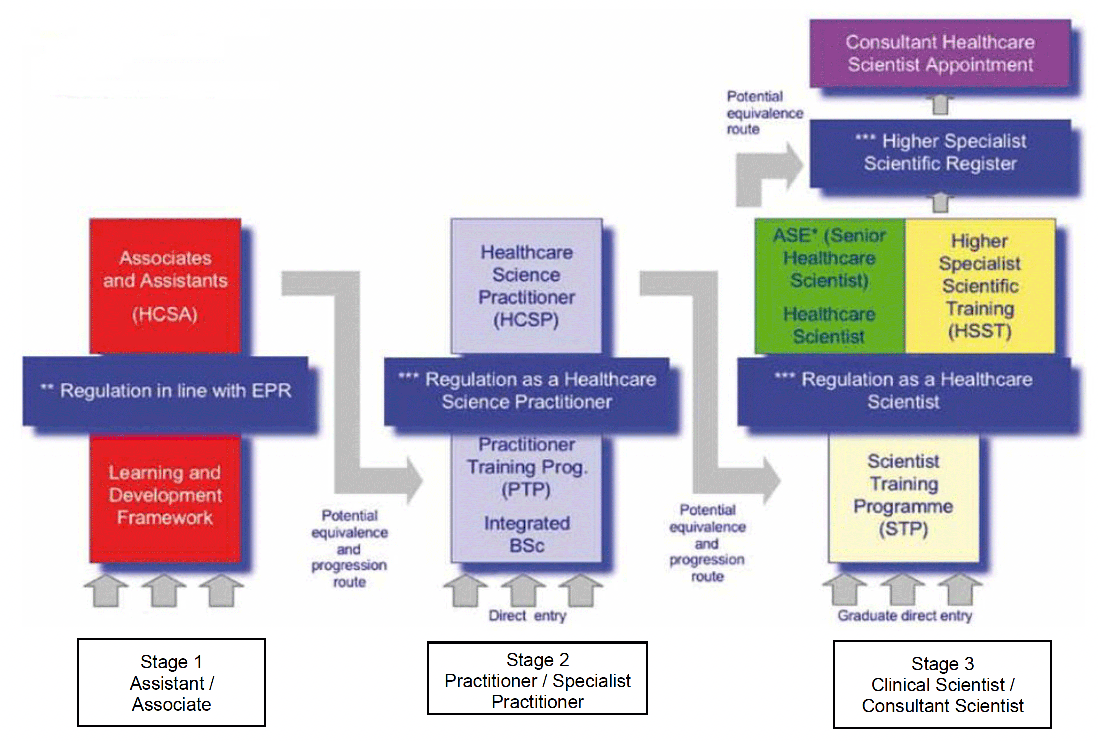Healthcare science - education and training provision: baseline review
This baseline review explores healthcare science education in Scotland to better understand this landscape. It has resulted in 6 key themes which will inform the national workforce strategy for health and social care in Scotland commitment to undertake a HCS Education scoping review.
3. Introduction and Background
3.1 Overview of Healthcare Science
HCS in Scotland is the fourth largest professional group comprising over 50 different specialisms with almost 7000 professionals. This workforce is distributed across 4 main professional groupings: Life Sciences; Physiological Sciences; Data Science and Physical Sciences and Biomedical Engineering (Figure 5). Collectively the HCS profession contributes to over 80% (5) of all clinical decisions within the acute; secondary and tertiary care environments working across the 14 territorial boards and 3 specialist boards (Public Health Scotland; National Services Scotland; NHS Golden Jubilee).

3.2 Modernising Scientific Careers Framework (MSC)
The UK MSC Framework (4) (Figure 6) aimed to provide a flexible, sustainable and standardised education and training pathway across all HCS specialisms. It proposed several benefits including better and faster diagnosis for patients due to a workforce aligned with the clinical team; support for the development of new roles and underpinning education and training; and a flexible and modular career pathway that would encourage, attract and enable effective workforce planning to be undertaken.

3.3 The National Workforce Strategy for Health and Social Care in Scotland
The strategy introduces the concept of the workforce journey - The "5 Pillars of the Workforce Journey" (Figure 7) and the need to understand this within the various professional groups to ensure that we have the appropriate workforce to support the overall aim and vision for our services.
The National Workforce Strategy for Health and Social Care in Scotland (3) strengthens the aspiration for a NHS workforce who not only have the correct knowledge and skills but also the appropriate support, terms and conditions and environment to ensure that they are able to progress their career as they so choose.
Figure 7: The 5 pillars of the workforce journey
- Plan - Improving the quality of workforce data will ensure that professional groups fully understand what path the employee has taken throughout their career
- Attract - Investing in education and training routes to attract the workforce of the future
- Train - Training our employees in order that they have the correct skills to deliver and develop service
- Employ - Improve terms; conditions; and environment for the employee to ensure that they want to work and innovate into the future
- Nurture - Improve culture and wellbeing to ensure that we have inclusive and supported workforce that are able to further their career should they so choose.
Understanding this workforce journey is vital to ensuring that our current workforce is competent to undertake their duties and provides insight into how we raise the visibility of the workforce to ensure that there is a continuous pipeline for the future.
3.4 HCS Workforce data
Data for the HCS workforce is not routinely or consistently collected in Scotland constraining effective workforce planning and the development and commissioning of education and training programmes.
Work has progressed within the Laboratory Sciences (6) to gather workforce data with an aim to understand the workforce and its gaps. The initial data gathering exercise carried out by the Diagnostics in Scotland Steering Group (DiSSG) workforce subgroup in 2019 demonstrated a number of initial inaccuracies regarding workforce information. The exercise, now in its third data collection year, has enabled the development of a robust overview of the laboratory specialties and has supported some of the regional and national work that has progressed for advanced/extended practice roles and the development of the education and training programmes that underpin them. This methodology has recently been adopted by the Physiology specialties.
The data captured within the Laboratory Science and Physiology specialities will support the work that will be undertaken in response to the Healthcare Science commitments within the National Workforce Strategy (3).
3.5 The future workforce
The "attract" pillar focuses on our future workforce and as such, attracting young people into and promoting the various HCS professions can be difficult due to the size and complexity of entry requirements for each of the specialisms. Raising the profile of HCS specialities to schoolchildren is of key importance particularly when subject choice can often determine entry requirements to the professions.
Education leading to qualifications that allow entry into the HCS workforce is not centrally coordinated however, the work underway in relation to improving workforce data will enable a clearer understanding of workforce future needs, enabling development of supporting education and training.
Contact
Email: sarah.smith@gov.scot
There is a problem
Thanks for your feedback